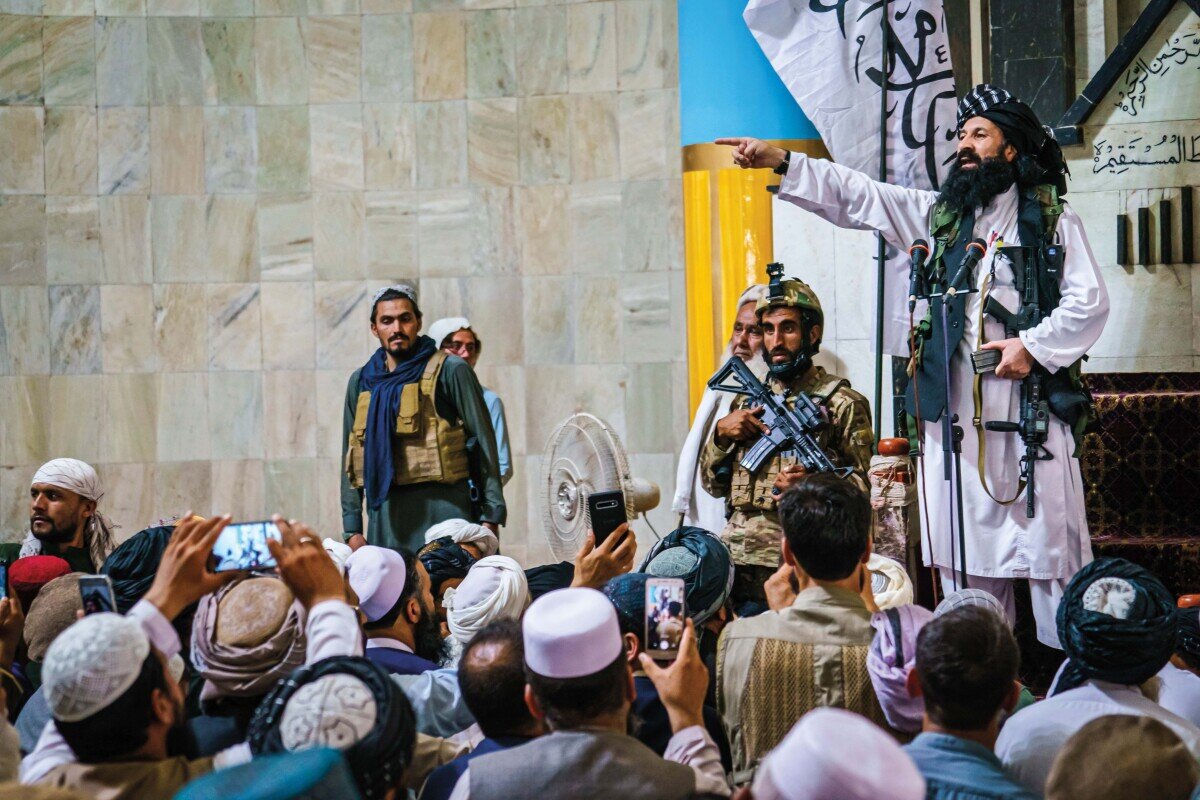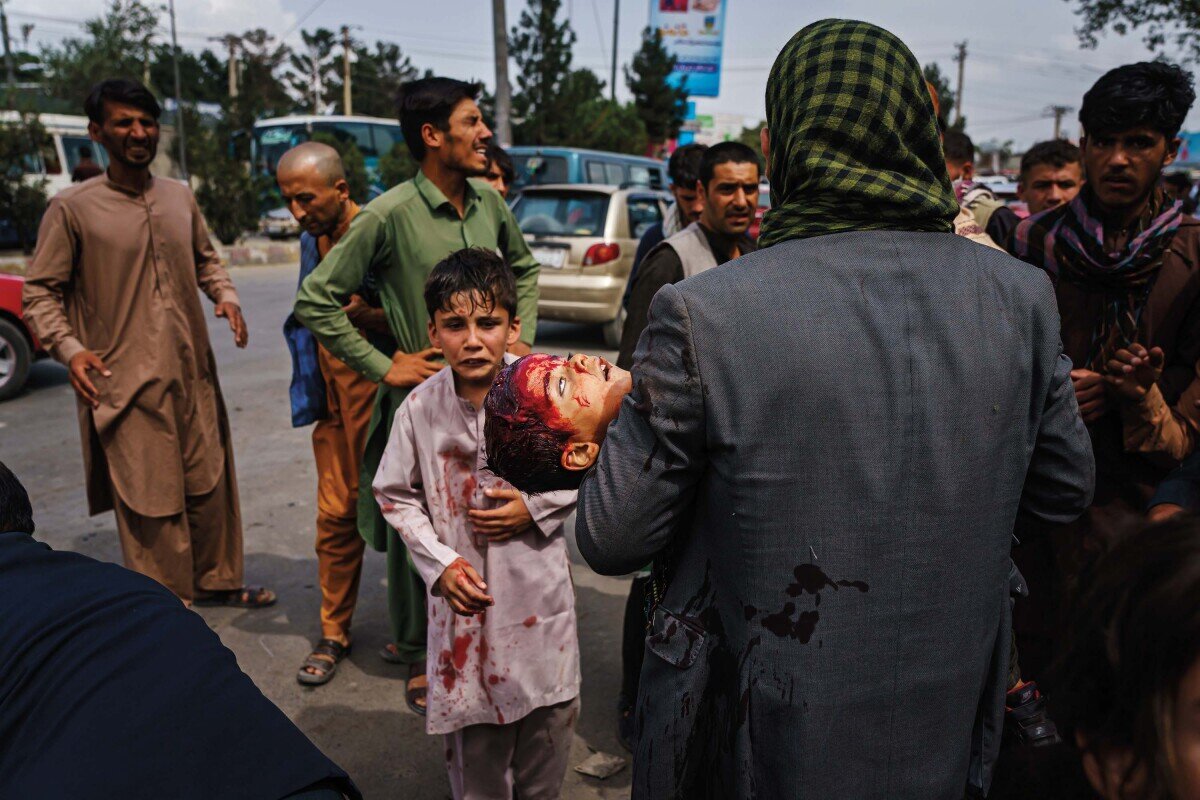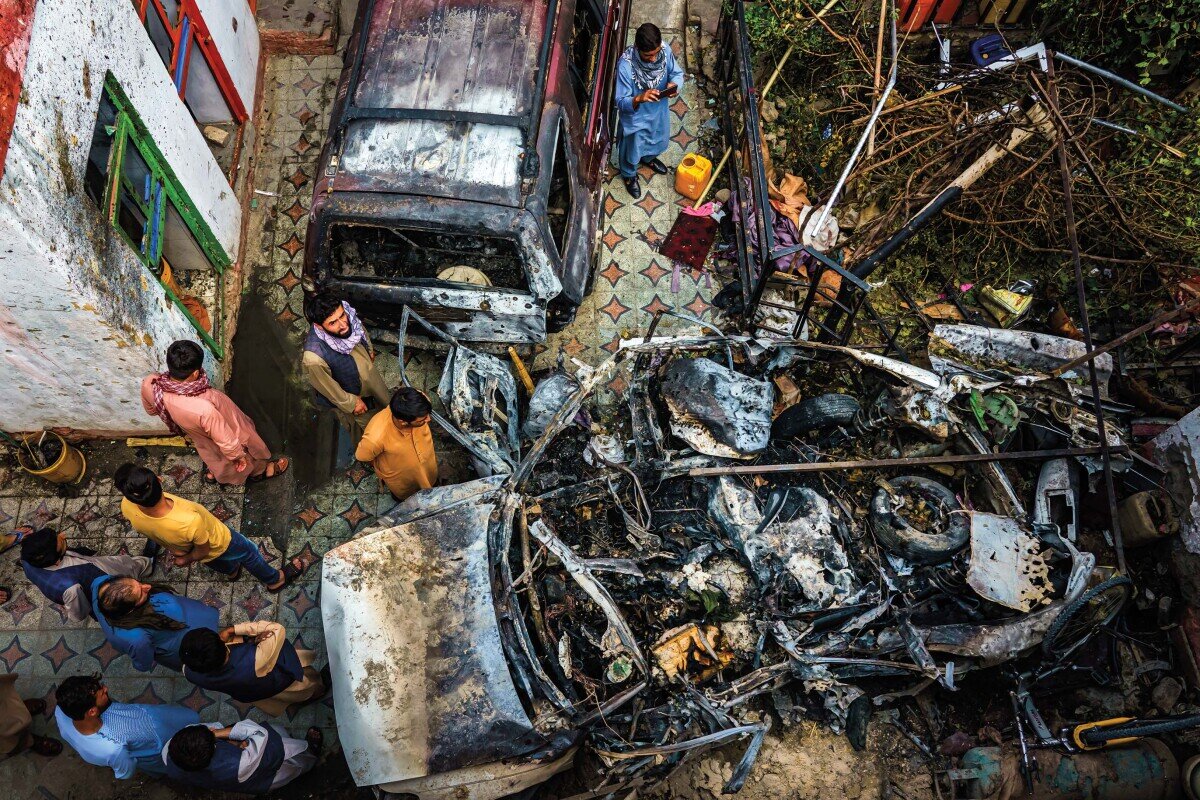With Enemies Like These, Who Needs Friends?
Immediately after the United States invaded Afghanistan in 2001, the Trumpet forecast that it would end in defeat for the world’s lone superpower. “While the U.S. wants to eliminate terrorism and is becoming much more aggressive in trying to do so, its efforts will fall short,” wrote Trumpet managing editor Joel Hilliker. “It frankly does not have the necessary will to tackle the enormity of the problem!” (November 2001).
Afghanistan’s collapse to the Taliban after America’s ill-conceived and shameful retreat has proved that forecast true.
That same 2001 Trumpet article made another astounding prediction—also based on biblical prophecy: “[W]e can see unequivocally that the terrorist snake will survive America’s aggression—head intact, and stronger than ever. … Make no mistake about it: Iran is the head of the snake.”
Realize the significance of this statement: Just as the world’s lone superpower invaded Afghanistan with the most sophisticated weaponry ever used in warfare, we prophesied that by the end of the failed campaign, not only would Islamic terrorism survive, but Iran, the chief sponsor of terrorism, would emerge stronger than ever.
Has that forecast come true?
It is easy to recognize America turning Afghanistan over to the Taliban as a victory for Islamist terrorism. Yet how will this affect Iran’s dominance as the head of the terrorist snake?
For over 30 years, Trumpet editor in chief Gerald Flurry has directed readers to focus on radical Islam led by Iran as being the fulfillment of the “king of the south” prophesied in Daniel 11:40: “And at the time of the end shall the king of the south push at him: and the king of the north shall come against him like a whirlwind, with chariots, and with horsemen, and with many ships; and he shall enter into the countries, and shall overflow and pass over.” This military push from the king of the south initiates a forceful response from the king of the north, which is the first step plunging the world into great tribulation.
This prophecy shows that a powerfully destructive, radical regime in Iran is a direct prerequisite for end-time events to occur.
Yet when Kabul fell to the Taliban, prevailing media opinion was that Iran feared what would come next. “Taliban Surge Will Force Iran to Forge a New Defense Strategy,” reported Haaretz on August 13. “Iran Braces for Life Next Door to the Taliban Once Again,” Bloomberg headlined on August 19. Germany’s Deutsche Welle wrote, “Afghanistan: Taliban Offensive Puts Iran in a Bind.” These three headlines represent the broad consensus that while Iran might be happy America is gone from Afghanistan, it is terrified of the Taliban.
This narrative is worse than false. It is dangerously naive.
The Taliban gaining power will not counter Iran’s hegemony in the region. In fact, not only did Iran plan for America’s eventual exit from Afghanistan—there is proof it also worked with the Taliban for almost a decade to bring it about.
The Taliban takeover gives the forces of radical Islam a massive economic, military and ideological boost. And the power that will benefit most is Iran.
Campaign to Strengthen the Taliban
As America retreated, Foreign Policy’s Shelly Kittleson was the only mainstream reporter to show Iran’s role in the Taliban’s gains. Writing from Kandahar in July and August, Kittleson documented several firsthand accounts of Iranian intervention inside Afghanistan that welcomed, encouraged, financed and fought alongside the Taliban in pushing out the U.S.
“Several sources I spoke to on the ground across the country during a monthlong reporting trip between July and August this year said that Iran has played a major role in the conflict,” Kittleson wrote. “While I was reporting from Kandahar, multiple security officials told me that Iranian weapons had been found in the hands of killed Taliban fighters in the area” (August 18).
She noted that when critical Iran-Afghanistan border crossings fell to the Taliban in early July, Iranian officials warmly welcomed the terrorists. Another curiously timed and underreported act of accord was the Taliban’s high-level visit to Tehran in July, right in the middle of its lightning offensive across Afghanistan.
Yet these are only recent examples of a brotherly relationship between former enemies. A search through open-source reports reveals that Iran has been allied with the Taliban for almost a decade.
In 2013, representatives of the Taliban participated in a conference on Islam in Tehran. During the visit, footage captured Taliban officials embracing Iranian Supreme Leader Ayatollah Ali Khamenei. The Wall Street Journal reported that by the end of 2013, Afghan security officials had evidence that Iran was training Taliban fighters inside its borders.
By 2015, the Taliban had its own footprint inside Iran. It had established four Taliban training bases in the Iranian cities of Tehran, Mashhad and Zehedan and in the province of Kerman. Initially, “Iran was supporting the Taliban financially,” a senior Afghan official told the Wall Street Journal in 2015. “But now they are training and equipping them too” (June 11, 2015).
That same 2015 article interviewed a Taliban commander from central Afghanistan whose salary was paid by Iran. “Iran supplies us with whatever we need,” he said. At the time, those supplies included 82-mm mortars, light machine-guns, AK-47 rifles, rocket-propelled grenades, and materials for making roadside bombs.
This boost in support for the Taliban was the work of the late Islamic Revolutionary Guard Corps (irgc) Quds Force commander Gen. Qassem Suleimani. The Middle East Eye reported that Suleimani visited Afghanistan in 2015, where he made several deals promising to “provide unlimited financial and technical support” to the Taliban. The Middle East Eye also reported that irgc officers went to Afghanistan to train and advise Taliban fighters. As part of the agreements, Iran provided Taliban leaders safe haven.

In 2016, Afghan officials in the western Farah province announced that members of the irgc were embedded in Taliban ranks. Farah Provincial Council head Jamila Amini told Radio France International at the time that 25 Taliban killed in a December 2016 battle were actually members of the irgc.
A year later, the New York Times published an investigative piece titled “In Afghanistan, U.S. Exits, and Iran Comes In.” It recapped a three-week “Taliban” siege of the city of Farah, where only a massive bombardment by the U.S. could rescue the Afghan troops. “[O]nly when the smoke cleared did Afghan security officials realize who was behind the lightning strike: Iran,” the Times wrote.
Among the deceased were four senior Iranian commandos, whose funerals took place in Iran. The wounded were sent to Iran for recovery.
Reporting on the gravity of this Iran-led attack, the New York Times wrote in 2017, “The assault, coordinated with attacks on several other cities, was part of the Taliban’s most ambitious attempt since 2001 to retake power. But it was also a piece of an accelerating Iranian campaign to step into a vacuum left by departing American forces—Iran’s biggest push into Afghanistan in decades” (Aug. 5, 2017).
In 2018, several mainstream media stories further showcased Iran’s role in the Taliban offensive. “Iran Funding Taliban to Affect U.S. Military Presence in Afghanistan, Say Police and Lawmakers,” headlined Arab News on May 27, 2018.
A month later, on July 2, the Times of London featured a report written from Kabul by Anthony Loyd, titled “Taliban’s Best Fighters Being Trained by Iran.” The first two paragraphs are shocking considering the Taliban’s takeover just three years later: “Hundreds of Taliban fighters are receiving advanced training from special forces at military academies in Iran as part of a significant escalation of support for the insurgents, Taliban and Afghan officials have told the Times.
“The scale, quality and length of the training is unprecedented and marks not only a shift in the proxy conflict between the U.S. and Iran inside Afghanistan, but also a potential change in Iran’s ability and will to affect the outcome of the Afghan war.”
Shortly before this Times piece, then U.S. Secretary of State Mike Pompeo became the first American official to expose what Iran was doing. He stated on May 21, 2018, “Iran’s support to the Taliban in the form of weapons and funding leads to further violence and hinders peace and stability for the Afghan people.”
Through 2019, Iran paid bounties to the Taliban to target coalition forces in Afghanistan. According to a Pentagon briefing seen by cnn, the Haqqani Network (part of the Taliban) was reimbursed for at least six attacks against the U.S. or coalition forces in 2019. On Dec. 11, 2019, the Haqqani Network executed a well-planned attack on Bagram Air Base in Afghanistan involving 10 of its members and an explosives-laden vehicle. U.S. air strikes were required to repel the attack, in which two civilians were killed and 70 were injured, including four American personnel.

This highly underreported event took place less than a month before U.S. President Donald Trump ordered the killing of General Suleimani. The justification for his assassination was a strike that had killed an American contractor in Iraq in late December. However, U.S. government officials told cnn that Suleimani’s push into Afghanistan was also part of the reason.
Nevertheless, Suleimani’s death on Jan. 2, 2020, did not slow Iran’s support for the Taliban. Instead, Suleimani’s number two, Ismail Qaani, took over the Quds Force. His domain of expertise is Afghanistan.
“Even though Suleimani’s death has affected Iranian subversive activities across the greater Middle East, its Afghanistan portfolio might actually get a boost because the man who managed it as Suleimani’s deputy is now his successor,” wrote the Hill (Feb. 6, 2020). Soon after, sophisticated antitank guided missiles, likely from Iran, started to appear on the Afghan battlefield.
According to the New York Times in July 2020, two coalition Black Hawk helicopters were hit by antitank missiles. The New York Times wrote, “American and Afghan officials claim the weapons used in both strikes were most likely supplied by Iran, but they offered no evidence to support the assertion. The accusation would be alarming if true, as the influx of anti-tank guided missiles could not only give the Taliban a tactical advantage over the Afghan military but also suggest Tehran was trying to undermine the American mission as it is poised to wind down” (July 30, 2020).
One year on, that article seems almost prophetic.
Don’t Ignore Iran
It is clear that by 2015, Iran was actively equipping, funding and training the Taliban as Tehran worked to remove the U.S. from Afghanistan. Thus, America’s defeat is not just a victory for the Taliban, it represents a surrender to radical Islamic forces led by Iran.
In the November 2003 Trumpet issue, Mr. Flurry prophesied that America’s war on terrorism would fail, specifically because America failed to go after Iran. “The fruits and evidence of the past two decades overwhelmingly prove where the king of state-sponsored terrorism is! The whole world can see that. However, the solution to terrorism lies in doing something about it! We must confront the source. The terrorist movement flows from Iran,” he wrote. “If the Iranian leadership were eliminated, the whole course of Mideast history would change radically for the better, because it is the king. Sadly, Bible prophecy reveals that will not happen.”
Indeed, it has not happened.
America has been unable to win in Iraq because it refused to go after the head of the terrorist snake: Iran. America has now been defeated in Afghanistan for the same reason. The Bible prophesies that Iran—not the Taliban, nor the Islamic State—will lead radical Islam. Whether it be from working with the Taliban or being called in to help check the Islamic State’s rise in Afghanistan, Iran will no doubt emerge far stronger after the Taliban’s takeover.

The Taliban and Iran are not enemies. They are fighting for the same team, and Iran is king.
Many observers are focusing on the threat Taliban rule might pose for the world, or wondering whether Iran’s power in the region will shrink. But Bible prophecy answers these questions.
Iran’s current push for regional control, and its quest for obtaining nuclear weapons to fulfill its genocidal ambitions, demands that we not take our eyes off Iran. What Mr. Flurry wrote about the Islamic State in Iraq in 2014 could be applied right now to Afghanistan: “The shocking barbarity of the Islamic State consumed a lot of the world’s attention the past few years. In one sense that was understandable. But if people had viewed those events in the context of Bible prophecy, they could have seen that there was an even bigger danger that was being overlooked” (Trumpet, January 2018).
That danger is the rise of Iran! While America’s defeat is an important fulfillment of prophecy in its own right, we must not allow the Taliban takeover to cause us to overlook how Iran-led radical Islam has been strengthened.
While this fact is concerning, God also intends it to provide a profound sense of hope.
Recall Daniel 11:40. This prophecy says that Iran and its radical Islamist supporters will become strong enough to initiate a violent conflict with a German-led European empire. This terrible conflict will thrust the whole world into great calamity.
But there is good news in the end. Daniel 11 does not just warn of tremendous war. It also describes events leading to Jesus Christ’s return.
Daniel 12 is part of the same vision. Verse 1 says the catastrophe and suffering surrounding the coming of the Messiah will be “a time of trouble, such as never was since there was a nation even to that same time ….” Thankfully, this period of chaos and war will last only 3½ years (verse 7). At the end of this period of terrible tribulation, God will powerfully intervene in world affairs. Yet this can only happen after the king of the south makes his prophesied push. Afghanistan’s fall to the Taliban surely accelerates the timetable.
In the context of Bible prophecy, the rise of radical Islam led by Iran is a sign that Christ’s return to Earth is imminent.
Then He will usher in a new age of peace and prosperity for all men. The wonderful new world government prophesied by Isaiah, Jeremiah, Micah and other prophets will be established on Earth. At this time, those who were faithful to God “shall shine as the brightness of the firmament; and they that turn many to righteousness as the stars for ever and ever” (verse 3).
Ultimately, this is where the present events in Afghanistan will end: in a dramatic climax that will see Jesus Christ come to end the age of man and begin a new world!
